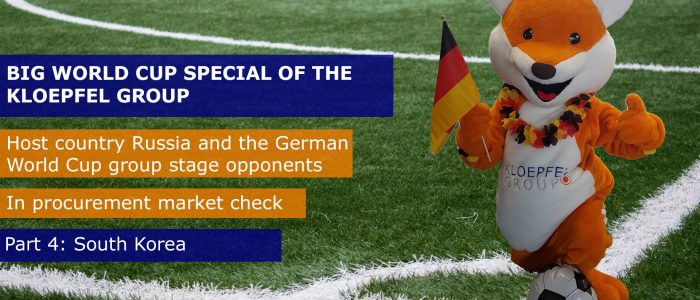Procurement market South Korea – The opponent of the World Cup in the check
On 27.06 Germany plays against South Korea. In the last part of our preliminary round series for the World Cup 2018, we will look together at the procurement market in South Korea and will take a closer look at the procurement, raw materials and imports and exports of our last opponent in the preliminary round.
Procurement in South Korea
South Korea is considered the fifth largest export country in the world. With around 51.25 million inhabitants and a total area of 100,210 square kilometers, the country offers many opportunities for procurement. After the end of the Korean War, South Korea belonged to the “lower league” of developing countries with a GDP per capita of USD 106. The “poor agricultural country” nevertheless became a “modern industrial state” as a result of the economic upturn and today has the eleventh largest national economy in the world. This upturn is due to the outward-looking economic strategy, which relied on exports to drive the economy. 2017 was a good year for the South Korean economy with very strong growth, low inflation, low unemployment and high investment activity.
In 2000 the GDP per capita was 11,947.58 US dollars, last year about 29,891.26 US dollars. Through this the country became place 15th in the ranking of the leading trading nations. Agriculture accounted for a rather smaller share of GDP with a total of three percent. In the last five years, around 99 percent of the customs duties have been dropped and in the same period EU exports to South Korea have increased by 55 percent, from Germany even by 70 percent. The latest import and export figures from 2017 also show that South Korea is in good economic shape: goods worth a total of USD 573.69 billion were exported and goods worth USD 478.48 billion were imported. Top export targets include Hong Kong in the third place (6.8 percent), the United States in the second place (14 percent) and China in the first place (26 percent).
Raw materials in South Korea
South Korea’s original core industry included shipbuilding and the textile industry. For this reason, the components and materials are highly developed in this area. South Korea is also the second largest coal importer in the world after Japan. As South Korea has only small deposits of hard coal and various ores, most of the raw materials that are important for industry must therefore be imported. South Korean industry is one of the most highly developed in the world and employs around 20 percent of all employees. Within the topic of work, South Korea is further developed than its neighbor China. The employees work 6 days a week with shifts of 10-12 hours. Nowadays, ships, cars, electrical goods, chemical products and textiles are mostly produced in the country.
The new trade agreement with the USA now allows the duty free import of steel. That means that in the future, around 70 percent (2.68 million tons) of the annual volume can be delivered duty-free to the USA.
The best known and largest companies are the car manufacturers Hyundai and Kia as well as the electronics groups Samsung and LG, which are among the world market leaders in displays and mobile phones. At the same time, however, caution is required, as declining sales by these groups could lead to problems in the growth of the entire Korean national economy. Korea is a closed marketplace. The components of a Korean car, such as glass, steel (Posco Steel) and tires (Kumho, Hankook, Nexen), all come from the domestic market. Thus, the industry is relatively broadly positioned.
Risks for the supply chain
The conflict with its neighbor North Korea can theoretically lead to problems for the supply chains of German companies. A worsening of the conflict could also become a problem for the production of electrical appliances and have a negative impact on the availability of smartphones, monitors, computers and tablets. At the moment (State early 2018) the relationship between the two sides is relaxed, but it is unclear how relations will develop further. However, current negotiations between US President Trump and North Koreans leader Kim Jong Un give reason to hope for a positive result.
Conclusion
So is the South Korean procurement market interesting for European companies? We say yes! Around 60 years ago, South Korea was part of the poorer developing countries. This has changed in the meantime, so that the country is constantly developing and growing. With its good infrastructure and attractive geographical location, the procurement market offers interesting opportunities for the purchase of German companies, such as capital goods, industrial small series with a higher finishing level (pumps, complex turned parts, etc.), high-quality consumer goods (e.g. leather cases from Mont Blanc) as well as technical textiles and raw materials (polyester fiber). A further plus point is certainly the legal security of the country. In contrast to China, contracts are strictly observed and the IP is respected.
About the author
Seoul Min – CEO NxTAsia Consulting Group
Seoul Min has been CEO of the NxtAsia Consulting Group since 2008. Under his leadership, NxtAsia Consulting has grown steadily both regionally and in terms of its service portfolio. Regionally, the focus is clearly on Asia. In his previous role, Seoul Min was Managing Director of the China office of Andlinger & Company, a private equity firm with offices in Europe and the United States. Before joining the Andlinger Group, Seoul Min managed the Asian business of an international consulting company focusing on supply chain management and purchasing optimization.
Would you also like to benefit from the know-how of our experts? Then feel free to contact us at +49 211 875 453 23 or at info@kloepfel-consulting.com.
Part 1: Procurement market Russia – The host country of the World Cup in the check
Part 2: Procurement Market Mexico – More than just Siesta!
Part 3: Procurement market Sweden – How strong is our preliminary round opponent?
Part 5: Procurement market Switzerland – Our neighboring country in check
Part 6: Procurement market Brazil: Is everything sweet in the land of the Sugarloaf Mountain?



Comments are closed.